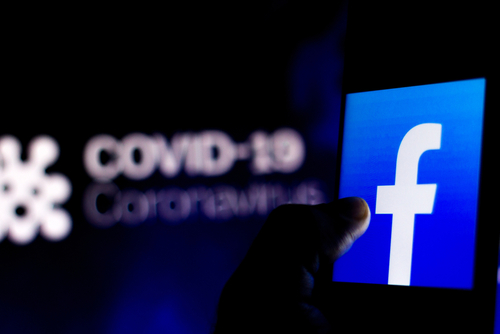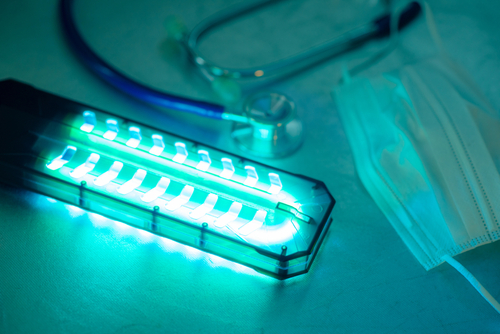With increased interest in using UV light to deactivate viruses, Robert Yeo, director at Pro-lite Technology, discusses the safety and effectiveness of UVC devices
Ultraviolet (UV) radiation has been in the media a lot recently. As life slowly starts returning to normal (or as normal as possible) and we start venturing out more following the Coronavirus lock-down, our attention turns to how we can minimise the risk of acquiring the virus ourselves, or of transferring it to others, particularly the more vulnerable members of society. The Government was clear from the outset that we should wash our hands thoroughly after contact with a potentially infected surface.
Then, on April 23, President Donald Trump speculated during a White House Coronavirus task force briefing that disinfectants and UV light were possible treatments for the virus. It is indeed the case that exposing your insides to UVC light will probably prevent you from falling victim to the virus, however that’s because the carcinogenic radiation will do you first.
As of April 30, a New York Times article reported that there were 780 Facebook groups, 290 Facebook pages, nine Instagram accounts and thousands of tweets promoting UV light therapies that were posted after Mr Trump’s comments. This is in addition to over 5,000 other social media posts promoting disinfectants as a virus cure.
As an example of businesses seeking opportunities in UV light therapies, one Colorado-based firm was quoted on April 30 by Bloomberg as promoting the use of UV LED light that it claims could be delivered into the lungs by means of a catheter inserted into the throat. However, the consensus from the medical community is that this technique is still at the research stage and as yet of unproven clinical efficacy.
Each new day brings ever more messages into my email inbox from firms offering me deals on UV LED light 'wands', devices which are being promoted as a means of sterilising surfaces and killing viruses. As to their effectiveness and safety, well that’s the subject of this article. Mr Trump has certainly managed to raise the public’s awareness of UV radiation. My aim is to balance the discussion with some science and facts.

Measuring UVC radiation
Scientists believe that UVC radiation may 'deactivate' the Sars-Cov-2 virus that is responsible for the Covid-19 respiratory disease. Although this thesis has yet to be proven, tests performed on related coronaviruses, including the Sars coronavirus, have revealed that UVC germicidal radiation is effective as a means of deactivating these viruses. In general, germicidal UV radiation is understood to damage (mutate) the RNA and DNA nucleic acids in a virus, which prevents replication, leading to its deactivation.
A key metric in the effectiveness of the UVC radiation is the 'dose' delivered. Dose is the product of a lamp’s irradiance and the cumulative exposure time. Irradiance is the total light (radiant flux) received at a surface per unit area of the surface exposed. It is expressed in units of Watts per square meter (W/m2). Dose is the product of irradiance and time (in seconds) and is expressed in units of Joules per square meter (J/m2).
Covid-19 is understood to be spread by coming into direct contact with respiratory droplets, or by transfer from an infected surface via a person’s hands to their mouth, nose or eyes. The extent to which the Covid-19 virus is spread via airborne transmission is not fully understood, but scientists are extremely concerned that airborne transmission is a real danger. Germicidal UV lamps are therefore being proposed both to irradiate contaminated surfaces and to irradiate the air in a room.
While UVC radiation is of proven utility in terms of its effect on viruses and bacteria, exposure to the human skin and eyes must be avoided. Notwithstanding the recent ill-informed speculation by certain politicians on the use of UV light on (or indeed within) the human body as a possible treatment for Covid-19, UVC is known to have a very harmful photobiological effect. Specifically, the use of UVC germicidal radiation for hand sanitisation is strongly discouraged. Also note that neither UVB (280-315nm) nor UVA radiation (315-400nm) provides for any significant germicidal disinfection. UVC lamps should be operated in strictly controlled environments, often within light-tight enclosures, to avoid the possibility of exposure to our skin or eyes. As with all sources of artificial optical radiation, UVC germicidal lamps must comply with the risk group labelling and safe use requirements given in EN 62471:2008, Photobiological Safety of Lamps and Lamp Systems.
How much UVC light is required for effective sterilisation?
The 'action spectrum' of the Covid-19 virus to UVC radiation is currently unknown. An action spectrum is the relative response as a function of wavelength for a given effect. However, a standardised germicidal action spectrum could be assumed to apply, and that published by the IESNA (the Illuminating Engineering Society of North America) is based on the deactivation of the E. coli bacteria which extends from 235 to 313nm, with a peak response at 265nm.
Anecdotally, a target irradiance of approximately 2mW/cm2 (equivalent to 20W/m2) at 254nm would require that the UVC germicidal light source remain stationary over the surface to be disinfected for tens of seconds. For a more complete description of the UVC dose required to achieve a 90 per cent deactivation (the D90 value) with a variety of Coronaviruses, please refer to this paper published on ResearchGate.net. The range of D90 values for the stated viruses ranges from 7 to 241J/m2, with an average of 67J/m2. This would be equivalent to exposing the virus to a mean irradiance of 1.116 W/m2 (or 0.1116 mW/cm2) for just over one minute.
However, this throws up a major concern. As with any light source, the irradiance delivered onto a surface varies with the separation between lamp and the irradiated surface. The irradiance follows an inverse squared relationship which means that if the source to sample separation is doubled, the irradiance will drop to 25 per cent of the original level. So it is incumbent upon manufacturers of UVC sterilisation products to specify the distance at which their lamp achieves its specified irradiance. Either that or the user must purchase a suitable UVC radiometer or an appropriately configured UV spectrometer system to measure the irradiance in-situ.
UVC light 'wands': Caveat emptor
The Covid-19 pandemic is being seen by a number of opportunistic business people as an excuse to market low cost, UV light 'wands' as a kind of miracle cure for disinfecting domestic surfaces of the virus. Some of these devices are of very questionable efficacy and it is clear that uninformed consumers are being taken advantage of.
An informal market surveillance conducted by the author revealed that most manufacturers offering low cost, consumer-orientated, UV light 'wands' failed to specify a working distance for their product, assuming even that they quoted an actual irradiance specification at all (most did not). This is extremely worrying, as the general public are not light metrology experts and cannot be expected to know that the effectiveness of these devices varies enormously both with the distance they are held over a surface and with the time that the surface is left exposed to the UV radiation.

Moreover, many of the UV light 'wands' on offer seem to suffer from a number of fundamental flaws. Some seem to be equipped with violet LEDs that do not emit in the required UVC band. Others seem to be fitted with plastic diffusers that would not transmit the UVC light anyway. Still more are being manufactured using UVC LEDs, but produce an intensity that is an order of magnitude lower than can currently be obtained from an equivalent discharge lamp, requiring that the wand be held over a surface for an excessively long time to achieve the required UVC dose. Also, few if any vendors take the trouble to point out that skin and eye exposure to the UVC radiation should be avoided, due to photobiological safety concerns.
Measuring UVC radiation
There are two optical radiation measurement methods used to quantify the amount of light emitted from a germicidal UV lamp – radiometry and spectroradiometry.
The simpler and lower cost method is to use a photodetector filtered to receive the 254nm peak emission from the low-pressure mercury lamp. This type of instrument is referred to as a radiometer and will be calibrated to record dose or irradiance in units of Joules per square meter or Watts per square meter (or equivalent) at 254nm. In their favour, such radiometers are affordable, portable, and simple to operate. Their main drawback is that they only reveal how much light is present at 254nm; they yield no information on the amount of UVC radiation as a function of wavelength over the entire UV or UVC waveband. Pro-Lite supplies UVC radiometers made by Solar Light Corporation, for details see: radiometers.
The more complete approach is to configure a spectroradiometer that measures the complete UVC (or entire 200-400nm UV) waveband and reports the irradiance as a function of wavelength (spectral irradiance). Often equipped with a flexible optical fibre with cosine receiver as the collection optics, the spectroradiometer will generally require the use of a laptop computer, so will not be quite as simple to use or as portable as a handheld radiometer; however, the recorded spectrum of the light source allows for the computation of its effectiveness, taking into account the actual (or presumed) action spectrum of the germicidal effect. Pro-Lite supplies modular spectrometer systems made by Avantes (see: AvaSpec-ULS2048) as well as the dedicated Specbos spectroradiometer made by JETI (see: Specbos 1211 UV).
In summary
UVC germicidal lamps are a proven means of disinfecting surfaces infected by all manner of bacteria and viruses, and the Sars-Cov-9 virus responsible for the Covid-19 respiratory illness is expected to be no exception. Key to the effectiveness of the UVC lamp is the irradiance delivered at a surface, which in turn is a function of the separation between lamp and the object being irradiated. To ensure that a sufficient UVC dose is delivered, the use of a purpose-designed UVC radiometer or spectrometer configured for UVC measurements is highly recommended. Caution should be exercised when considering the use of low cost, consumer-orientated UV light 'wands' that are currently flooding the market, as these have a dubious efficacy and questionable photobiological safety. UVC germicidal lamps are emphatically unsafe for exposure to unprotected human eyes and skin, and must not be used for hand sanitisation under any circumstances.
Further information

